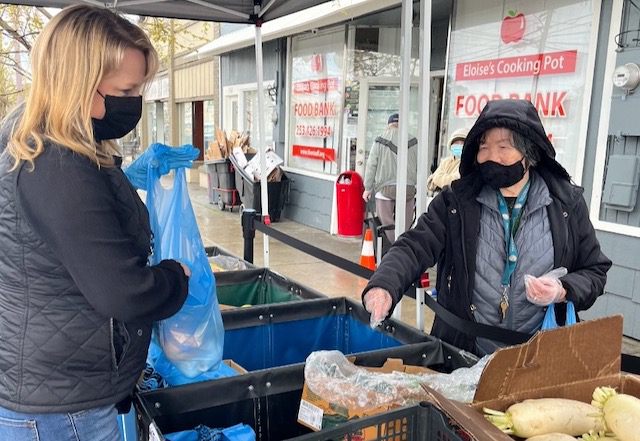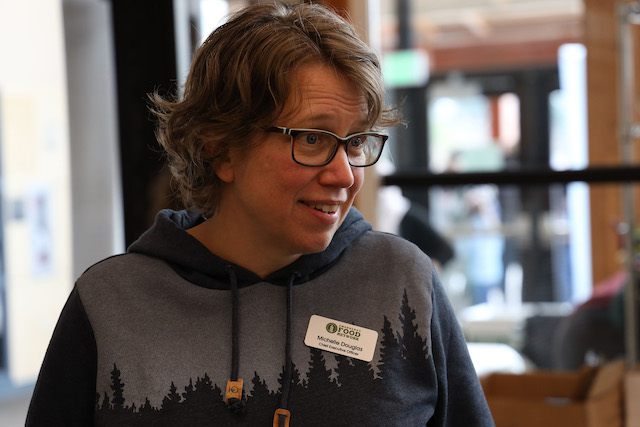
Prior to the pandemic, food banks nationwide were already busy, but COVID amped up the client numbers and it hasn’t subsided. In fact, with the high cost of living these days, especially where food is concerned, more families who had never dreamed of needing food bank services are relying on them and this number is only going to keep going up.
In Tacoma, some food banks like Eloise’s Cooking Pot on McKinley Avenue are just where they need to be – in “food deserts” where there is no major grocery store nearby. Having to go across town to shop for food is particularly hard on families who don’t own a vehicle, and carrying bags of groceries home on a bus isn’t always the answer. For families with little kids in tow, for seniors and those with physical disabilities, it can be impossible.
Those with special dietary needs represent another facet of concern. Whether it’s diabetes, heart or kidney disease, cancer, or any other serious health condition, these individuals need choices that accommodate their health matters and food banks work hard to accomplish this necessary task.
FOOD AND FUNDING DECLINE
The Tacoma Adventist Community Food Bank on Portland Avenue specializes in serving clients with significant health issues, making it necessary to purchase fresh fruits and vegetables at around $800-$1,000 a week. The food bank also purchases canned foods with low sodium and low sugar since these are not commonly part of the food stock received from donors.
Adventist Community Food Bank volunteer coordinator Lori Caley-Thorne said things have really changed even though COVID subsided.
“During COVID, we started getting a lot of food. I could get a truckload of produce boxes – more food than we could use – then all that dried up, and the money and the semis stopped rolling in,” she said.
Pandemic food availability allowed the food bank to serve clients it normally wouldn’t, people not on special diets who Caley-Thorne said started showing up during COVID.
“We had all this extra food so we would take anybody in need. But now, I still have a ton of people, but funding has dried up. Luckily, we have enough food for anyone who shows up but how long that will last, I don’t know,” she said.
What our local food banks accomplish is astonishing. Eloise’s Cooking Pot served about 69,000 people last month alone and distributes about 1.5 million pounds of food a month.
“The pressure is crazy,” said Eloise’s founder and Executive Director Ahndrea Blue. “People assume that because of COVID, people needed food. What I think happened is that people needed food before COVID but didn’t feel comfortable. COVID put such a spotlight on food and food insecurity that people now feel more comfortable coming to food banks.”
Blue said another matter is that funding for food banks is being diverted to other issues like homelessness and housing. “People still need food. EBT cards were reduced, food prices are three times more than prior to COVID, and all expenses have gone up. Now you have people still in crisis with food more than ever.”
Emergency Food Network Executive Director Michelle Douglas said EFN is seeing more people than ever before.
“There are more visits to the emergency food system right now than there has ever been in the history of the network,” she said. “In 2022, we saw over 2 million visits to the network, which was more than we’ve ever seen, and we’re on track to see 2.5 million this year – a 30 percent increase over 2022. It’s staggering.”
EFN is a major source of food for its more than 75 partner programs across Pierce County, which includes 70 food pantries like Eloise’s Cooking Pot and the Adventist Food Bank, eight meal sites and shelters. EFN has its own home delivery service as well and provides food to children while they are on break from school and unsure whether there will be food at home.
Douglas and Blue say that not everyone can eat the same kinds of foods, nor should they be expected to. This is where culturally appropriate foods come into play.
“It’s the food they normally cook and eat, and we have an obligation to provide the best food, not the best for my budget,” Blue said. At Eloise’s, people get to pick their own food with dignity and respect. “We belong to the people, and they get to decide what to eat. My job is to bring the food that you requested me to bring.”

This is why over half of the food Eloise’s puts on the shelves must be purchased since it is not getting donated. It’s the same at EFN.
“It’s a combination for us too,” Douglas said. “In 2019, we bought about $400,000 worth of food then in 2020 at the height of COVID, we bought about $2.2 million and now we’re averaging about $1.6 million. What’s happening is the donated stream across the country has really decreased. Ironically, less food is being distributed to food banks via donation than pre-COVID. It’s two competing things – we have a huge increase in client visits and a huge decrease in donated food.”
The quality of donated food is also dwindling. “A lot of food banks over time have become dumping grounds for things like cabbage that they can’t sell at the grocery store. They think somebody can cut away all the bad parts and use the center, so we’ll send that to the food pantry,” Douglas said.
WHERE TO FROM HERE?
Blue said it’s important for everyone to remember how close they are to being one paycheck away from homelessness or needing food. “Don’t insult the people. They are entitled to the food they would normally eat,” she said. “As a food bank, we should have the best food on the planet, not the sub-standard food that’s on its way to the trash can that we give to you and feel like we’ve done something.”
Blue and Douglas both agree that it’s time to evolve past the notion that providing food is a favor to the people who need it and to embrace the fact that food is a right and not a privilege.
“Everybody should have a right to have food and without judgement,” Blue said. “They are entitled to eat the food that they want to eat, not food that people deem is healthy or appropriate. No one has a right to tell anybody what to eat, but everyone has a right to have food.”
It’s time to rethink and transform food banks from the model that has pretty much stayed the same for as long as anyone can remember. Katie S. Martin, executive director of the Foodshare Institute for Hunger Research and Solution in Connecticut, affirms this in her new book “Reinventing Food Banks and Pantries: New Tools to End Hunger.”
Martin calls for an end to the age-old view that hunger is a short-term emergency. She writes: “If we define hunger as a symptom of poverty caused by a broken system, and rooted in social inequalities, then the solution becomes quite different.”
Douglas believes a shift in consciousness is necessary. If we want our population to be healthy and whole and we want people to thrive and not just survive, we must be sure they have access to good, quality food.
“We need to stop thinking that the food pantry is this thing we do for people but rather take on the understanding as a culture and a country that food is a right – a basic right – and that part of what we do is to guarantee that people have their most basic needs met. Food and shelter are at the top of that list.”
Anxiety over running out of food before there’s money to buy more means having to live in what Martin calls the “tyranny of the moment” over that day’s finances and an empty refrigerator. She says it is a common phenomenon that should not be taken lightly by those who can do something to help. This includes federal legislators, states, cities, counties, and wealthy corporations alike who can direct more major funding to food banks and meal programs.
Food bank operators are very resourceful in how they can stretch a dollar so that money would be put to good use. It could even allow for a paid staff that can keep these food sources open all day and up to seven days a week. More funding could allow food banks to be more stable by purchasing permanent locations rather than having to shell out rent every month as some do.
No one should have to suffer with food insecurity, especially in the U.S. where tons of food end up in the trash and landfills. It’s pretty clear that a lot of people in Tacoma get it. They have a heart for feeding everyone in need, with little free pantries and free food tables popping up in front of houses in all kinds of neighborhoods across the city. But this isn’t enough to make sure food resources get to where they’re most needed, nor to ensure that downturns in the economy won’t negatively impact people’s only way to feed themselves and their loved ones.
How do we meet the ever-growing need for food? Douglas says it’s going to take all of us.
“I don’t think anybody is going to hit this need alone. We need more funding but also, we need some strategic changes. Look how many kids were pulled out of poverty with the Child Tax Credit and we just let that go. We need a change in how we think about hunger in America and how we assess what ‘making it’ is. We talk about ‘just pull yourself up by your bootstraps,’ but we’re never talking about if you even had a boot to begin with.”
Douglas, Blue and Caley-Thorne voiced much gratitude for the volunteers that make their food banks work. This is how dollars can be stretched and maximized, and it is a great boost to the people who work at food banks every day to have that community support. There are many ways to get involved either with time, financial donations in which no amount is too small, or even to take part in EFN’s Abundance Dinner and Auction coming Oct. 28 to the McGavick Conference Center in Lakewood. Learn more at efoodnet.ejoinme.org/register2023.
As Blue said, “The crisis is bigger than it ever has been before. Just because COVID ended, people still need to eat. I need people to go back to the mentality during COVID when they came out to help at food banks. I need people to go back to that. I need them to come back.”

